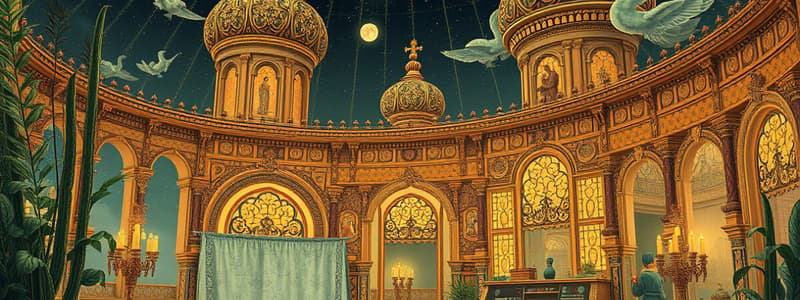Podcast
Questions and Answers
What is one of the main characteristics of Sumerian art?
What is one of the main characteristics of Sumerian art?
- Incorporation of bright, vivid colors
- Use of geometric shapes and patterns
- Focus on hyper-realistic human forms
- Emphasis on religious and ceremonial themes (correct)
Which material was commonly used in the creation of Sumerian sculptures?
Which material was commonly used in the creation of Sumerian sculptures?
- Marble
- Wood
- Clay
- Bronze (correct)
What purpose did carved cylinder seals serve in Sumerian culture?
What purpose did carved cylinder seals serve in Sumerian culture?
- To create large murals in public spaces
- As decorative ornaments for clothing
- To mark ownership or authenticity of documents (correct)
- For religious offerings to deities
How did Sumerian artists depict the human figure in their artwork?
How did Sumerian artists depict the human figure in their artwork?
Which technique was primarily utilized in Sumerian pottery?
Which technique was primarily utilized in Sumerian pottery?
How did Sumerian art reflect the society's religious beliefs?
How did Sumerian art reflect the society's religious beliefs?
What role did narrative play in Sumerian artistic expressions?
What role did narrative play in Sumerian artistic expressions?
In what ways did Sumerian sculpture differ from their pottery?
In what ways did Sumerian sculpture differ from their pottery?
How did the use of cylinder seals impact Sumerian commerce and administration?
How did the use of cylinder seals impact Sumerian commerce and administration?
What significance did the depiction of animals hold in Sumerian art?
What significance did the depiction of animals hold in Sumerian art?
Flashcards are hidden until you start studying
Study Notes
Overview of Sumerian Art
- Sumerian art marks one of the earliest forms of artistic expression in ancient civilizations, emerging around 4500 BCE in Mesopotamia.
- It is characterized by a focus on both religious and political themes, reflecting the society’s values and beliefs.
Materials and Techniques
- Common materials include clay, stone, and metal, with clay being pivotal due to its abundance and ease of manipulation.
- Techniques such as carving, molding, and casting were employed, producing intricate sculptures and reliefs.
Sculpture
- Statues often depicted deities, rulers, and worshippers, designed for temples or public spaces.
- Notable sculptures include the cylindrical votive figures, which represented worshippers in fixed poses, emphasizing devotion.
Architecture
- Ziggurats were prominent structures, serving both religious and administrative purposes, constructed with mud bricks in impressive tiered designs.
- The Great Ziggurat of Ur is a prime example, demonstrating the engineering skills and religious dedication of the Sumerians.
Reliefs and Inscriptions
- Bas-reliefs depicted scenes of daily life, mythological narratives, and historic events, often adorning walls of temples and palaces.
- Cuneiform inscriptions, the earliest known writing system, frequently accompanied artworks, providing context and record-keeping.
Influence and Legacy
- Sumerian art influenced subsequent cultures in Mesopotamia, leading to advancements in artistic techniques and thematic representation.
- Elements of Sumerian artistry are evident in later periods, showcasing its role in shaping the trajectory of ancient art history.
Studying That Suits You
Use AI to generate personalized quizzes and flashcards to suit your learning preferences.




